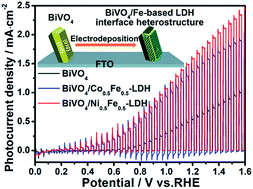Interface engineering of 3D BiVO4/Fe-based layered double hydroxide core/shell nanostructures for boosting photoelectrochemical water oxidation†
Abstract
Photoelectrochemical water oxidation driven by photocatalysts is one of the most effective ways for converting solar energy into fuels and chemicals. However, to date, the solar conversion efficiency using the established photocatalysts is still low. Herein, we report a new strategy for making a class of three-dimensional (3D) BiVO4/Fe-based (Ni1−xFex and Co1−xFex) layered double hydroxide (LDH) interface heterostructures for boosting the photoelectrocatalytic water oxidation performance. Compared with the BiVO4, the BiVO4/Ni0.5Fe0.5–LDH interface photoanode exhibits about 4-fold photocurrent enhancement at 1.23 V vs. the reversible hydrogen electrode and remarkable negative shift (320 mV) of the onset potential for the oxygen evolution reaction (OER). Theoretical calculations reveal that the enhanced photocatalysis for the OER is mainly attributed to the optimal light absorption and the acceleration of electron–hole separation enabled by the strong electronic coupling at the BiVO4/NiFe–LDH interface. The present work first highlights the importance of tuning the light absorption and the separation of carriers using interface engineering in enhancing the solar photocatalytic performance.



 Please wait while we load your content...
Please wait while we load your content...